How to see the green comet C/2022 E3 (ZTF) visible in the night sky now as it approaches Earth
Don't miss your chance to see this visitor from the outer reaches of our solar system as it prepares to make its closest approach to Earth.
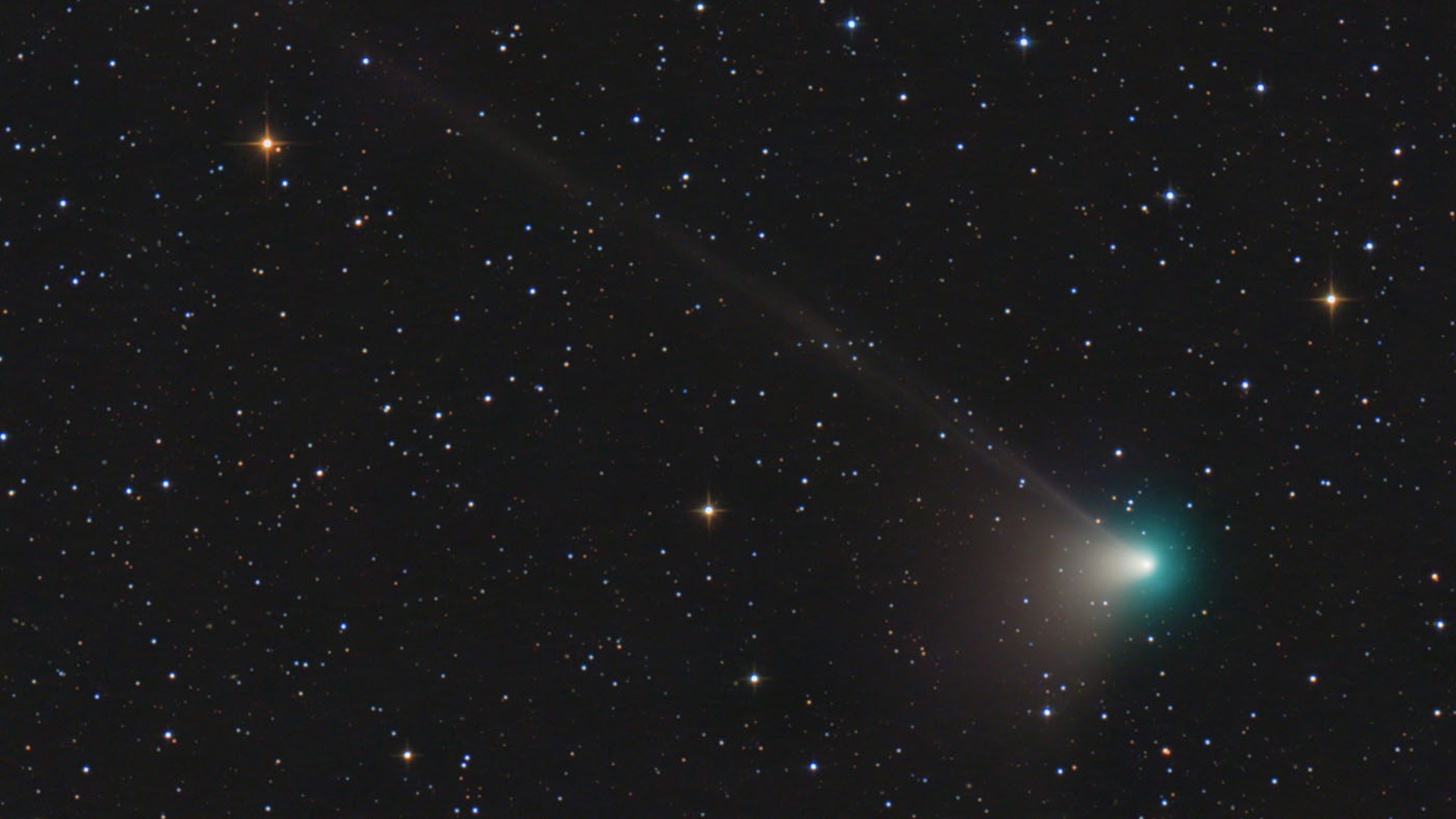
The gorgeous green comet C/2022 E3 (ZTF) should now be visible to the naked eye under the right dark sky conditions.
The comet is rapidly approaching perigee, its closest point to Earth, which is making it easier to spot in the night sky. The comet, first discovered in March 2022 by astronomers Frank Masci and Bryce Bolin using the Zwicky Transient Facility (ZTF) at the Palomar Observatory in California, has been brightening since November, wowing astrophotographers with its brilliant green tail.
Comet C/2022 E3 (ZTF) is currently making its way through the northern skies and should reach its brightest magnitude in early February, according to In-The-Sky.org as it approaches perigee on Feb. 1. To see the comet for yourself, look to the north just after sunset and look for a faint greenish glow. Under the right dark sky conditions, the comet could be visible to the unaided eye, but binoculars will certainly make the job easier.
Related: Amazing photos of the green comet C/2022 E3 (ZTF)
More: How to view and photograph comets

Looking for a telescope to see comet C/2022 E3 ZTF? We recommend the Celestron Astro Fi 102 as the top pick in our best beginner's telescope guide.
Comet C/2022 E3 (ZTF) is available for tracking in most major astronomy and sky tracking apps. Additionally, University of Toronto astrophysicist Hanno Rein has created a free app available on the Apple app store dedicated entirely to locating and tracking comet C/2022 E3 (ZTF).
As of Monday (Jan. 23), comet C/2022 E3 (ZTF) appears close to the constellation Draco. The images below are courtesy of TheSkyLive.com.
Related: See '3 days in the life' of green comet as it heads towards Earth (photo)
Get the Space.com Newsletter
Breaking space news, the latest updates on rocket launches, skywatching events and more!
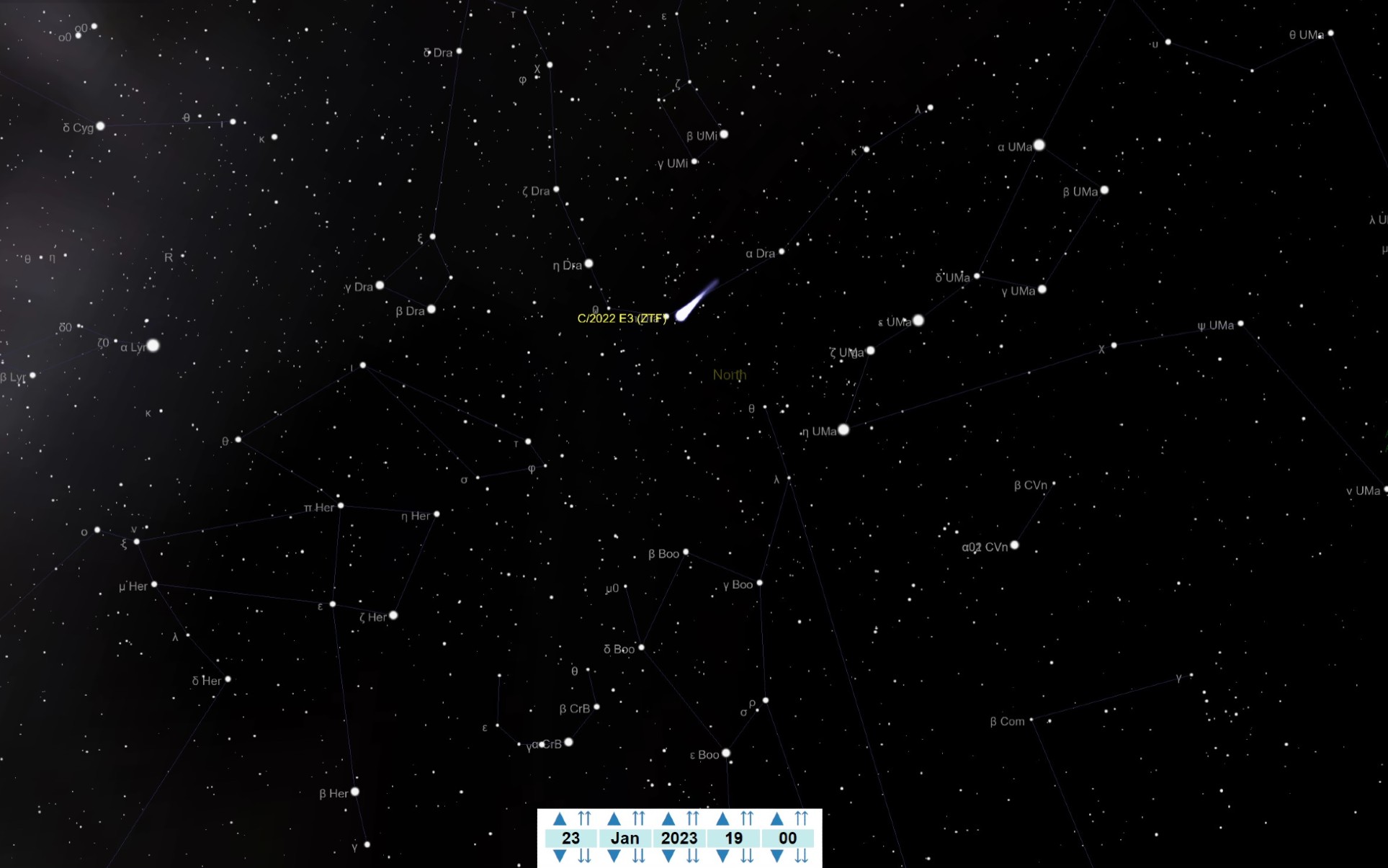
On Thursday (Jan. 26), the comet will appear just beside Ursa Minor, the "Little Bear" or "Little Dipper."
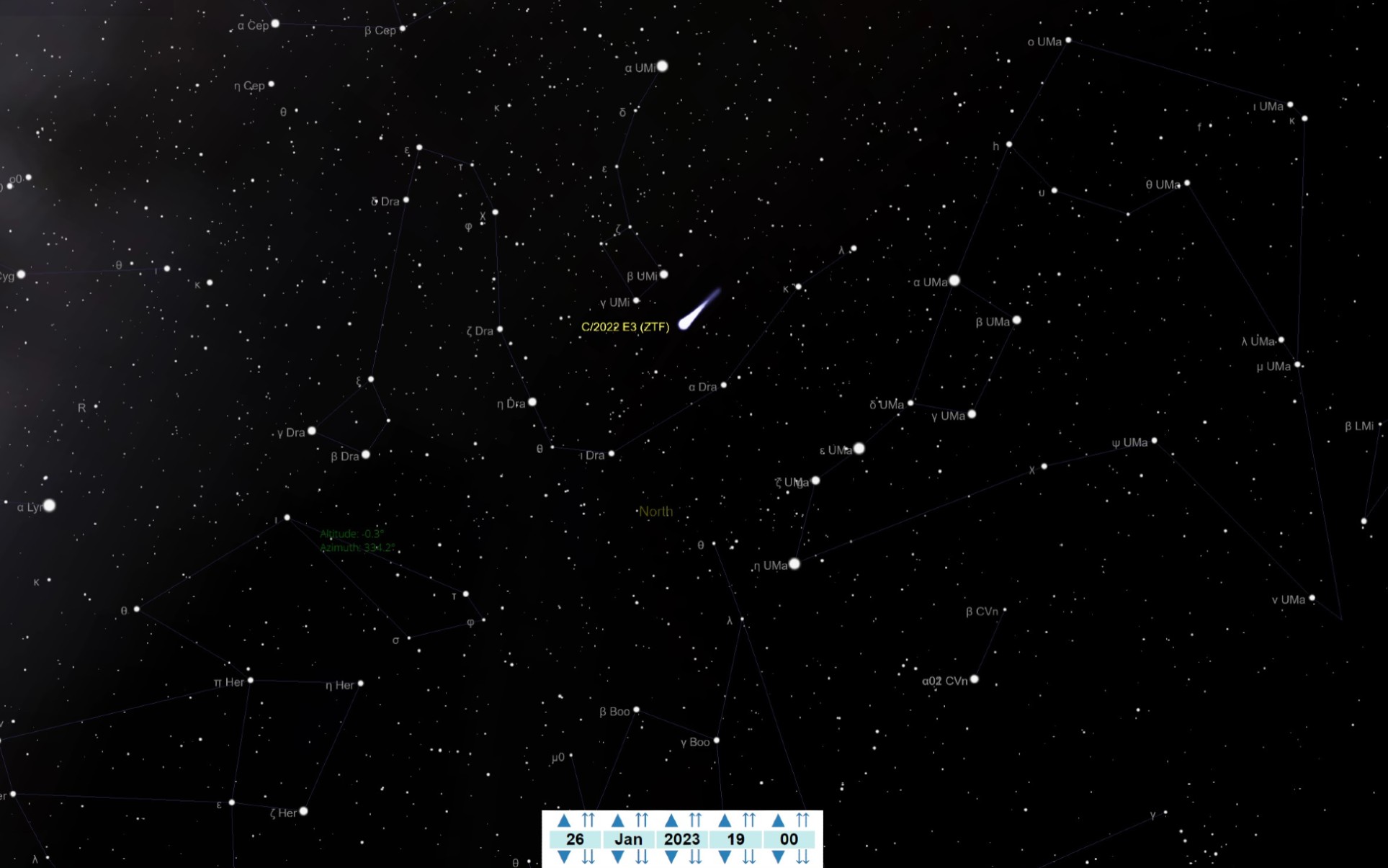
By Jan. 30, the comet will make its way east toward Camelopardalis, where it will appear when it reaches perigee on Feb. 1.
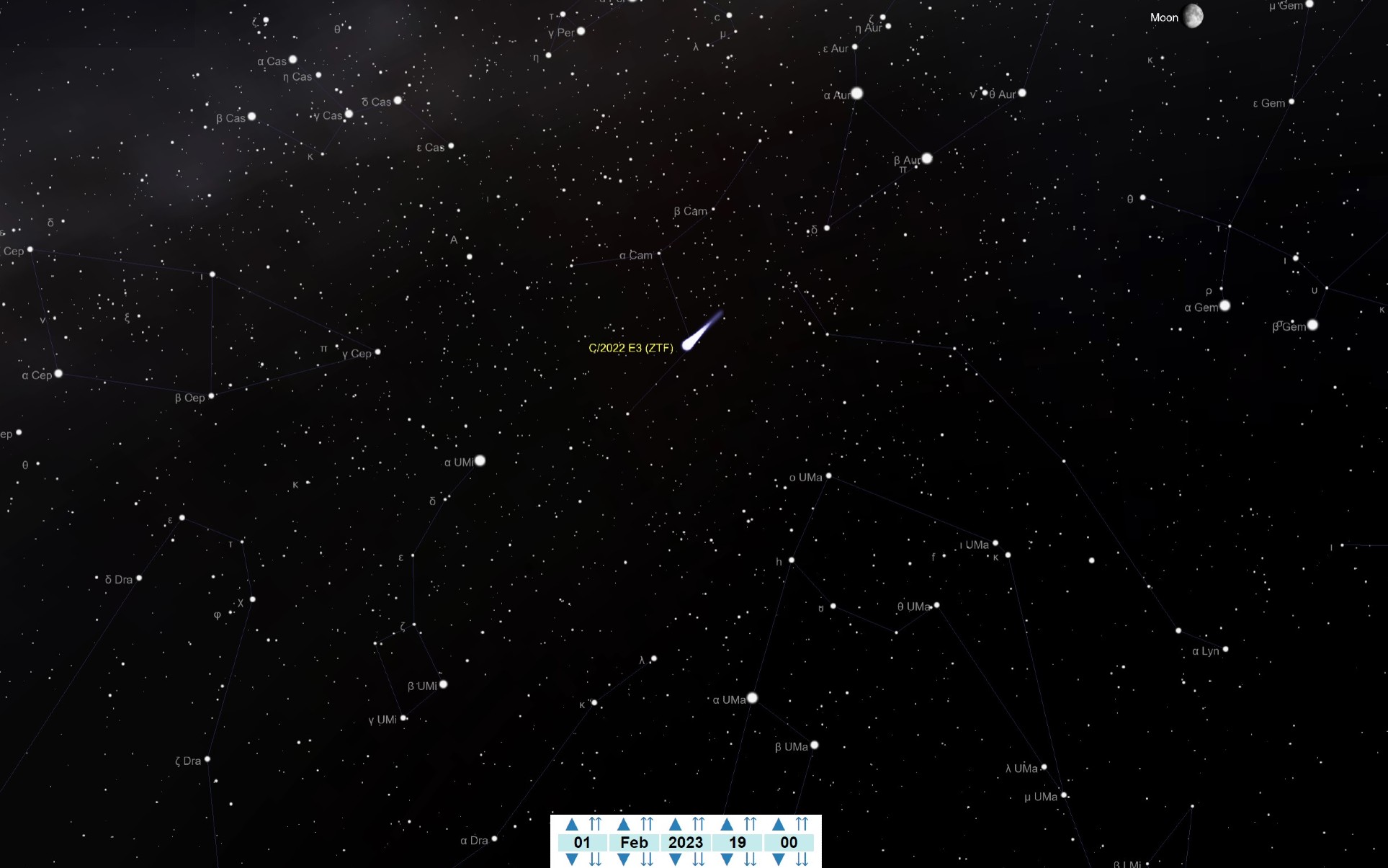
By Feb. 10, the comet will have moved significantly to the east and will appear close to Mars, which might make it easier to spot.
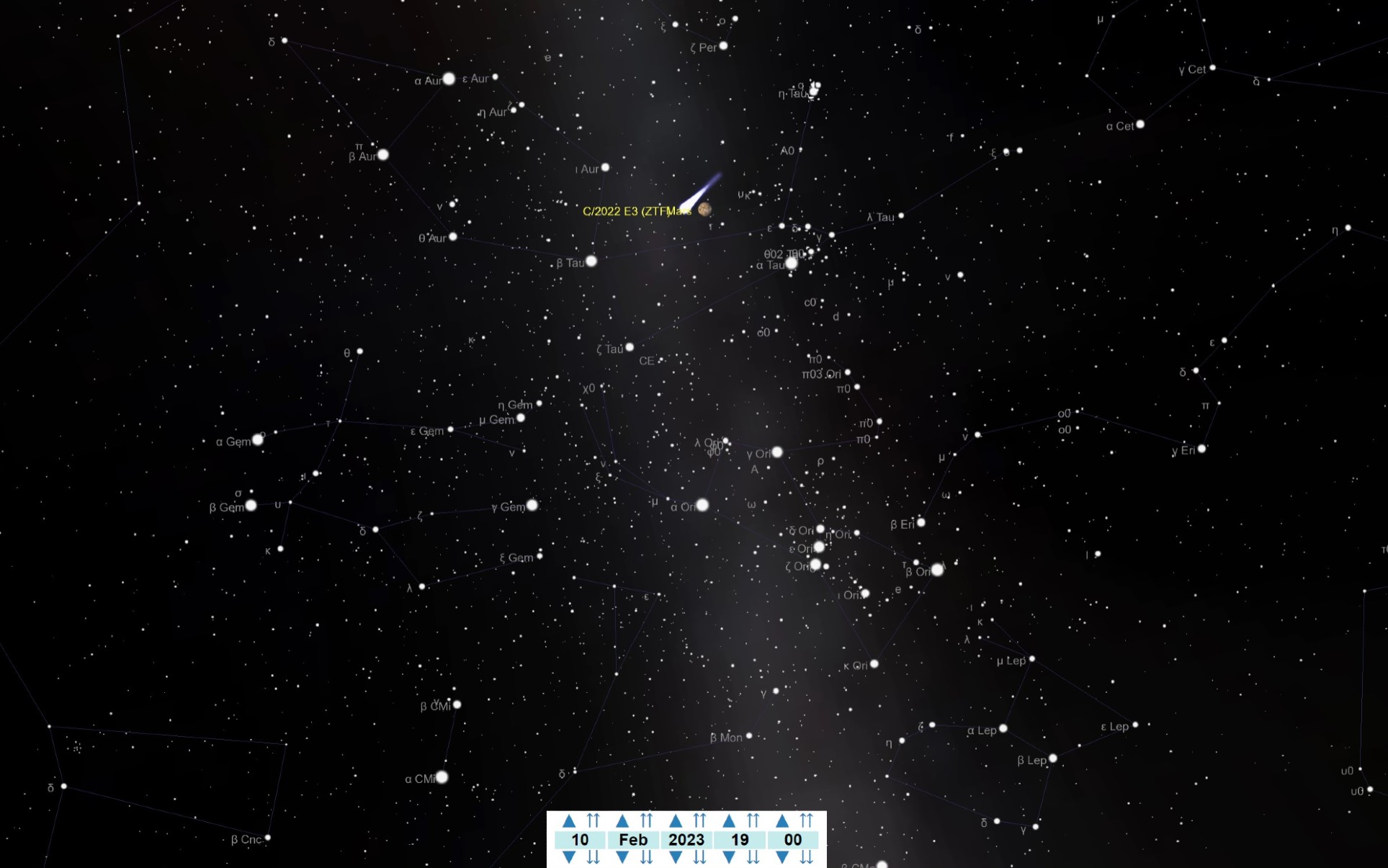
If conditions aren't right for late night or early morning skywatching in your area, you're still in luck: The Virtual Telescope Project will be hosting a free livestream of comet C/2022 E3 (ZTF). The stream begins on Feb. 1 at 11:00 p.m. EST (0400 GMT) and can be watched courtesy of the project's website or YouTube channel.
Comet C/2022 E3 (ZTF) has already put on quite a show for astrophotographers, leading to scores of breathtaking pictures of the gorgeously green comet. In January, strong solar winds caused part of the comet's tail to break off in what astronomers call a disconnection event.
More recently, SpaceWeather.com reported that comet C/2022 E3 (ZTF) formed what is known as an "anti-tail," a phenomenon which causes a comet to appear to have a second, forward-facing tail. In reality, an anti-tail is an optical illusion caused when larger dust particles form a disk along the comet's orbit. As Earth passes through the comet's orbital plane, this dusty disk can be seen side-on, appearing as a reversed anti-tail.
Hoping to observe C/2022 E3 (ZTF)? Our guides on the best telescopes and best binoculars can help, as it doesn't take much magnification to see the comet as the month comes to a close. You can also check out our guides on how to view and photograph comets, as well our best cameras for astrophotography and best lenses for astrophotography to get started.
Editor's Note: If you get a great photo of comet C/2022 E3 (ZTF) and would like to share it with Space.com’s readers, send your photo(s), comments, and your name and location to spacephotos@space.com.
Follow Brett on Twitter at @bretttingley. Follow us @Spacedotcom, or on Facebook and Instagram.
Join our Space Forums to keep talking space on the latest missions, night sky and more! And if you have a news tip, correction or comment, let us know at: community@space.com.

Brett is curious about emerging aerospace technologies, alternative launch concepts, military space developments and uncrewed aircraft systems. Brett's work has appeared on Scientific American, The War Zone, Popular Science, the History Channel, Science Discovery and more. Brett has English degrees from Clemson University and the University of North Carolina at Charlotte. In his free time, Brett enjoys skywatching throughout the dark skies of the Appalachian mountains.
-
rod Some early morning comet viewing today :) Easy to see now using 10x50 binoculars and my 90-mm refractor telescope.Reply
Observed 0200-0330 EST. First Quarter Moon 28-Jan-2023 1519 UT. Easy to locate C/2022 E3 (ZTF) comet this morning. Theskylive.com reports magnitude 5.6 now. Stellarium 1.2 shows C/2022 E3 (ZTF) about 1 degree 51 arcminute angular separation from Edasich in Draco when I started observing. Distinct, bright 10x50 binocular view and simple to locate using Telrad with my 90-mm refractor telescope. I used TeleVue 14-mm Delos eyepiece (71x) for a bit more than 60-arcminute true FOV along with 10x50 binoculars. Draco stars HIP74756 (7.60 magnitude) and TYC4181-1286-1 (8.90 magnitude) are about 8 arcminutes apart from each other, visible in the FOV with the comet. C/2022 E3 (ZTF) distinct coma about same angular size (8 arcminutes), visible with slight fan shape and some tail now, perhaps 15-20 arcminutes faintly visible across the FOV at 71x using. Stellarium 1.2 reports coma diameter about 17 arcminutes or so and gas tail length close to 1.5-degrees. Other fainter stars visible along with C/2022 E3 (ZTF). This was fun comet observing with clear skies, temperature -2C, winds 280/5 knots. I started observing comet C/2022 E3 (ZTF) on 24-Dec-2022 when magnitude 8.59 was reported. I did not see unaided eyes because of light pollution towards N and NE sectors, I can see about 5.0 or so magnitude stars in those directions but very easy using 10x50 binoculars now and 90-mm refractor telescope. The woodburning stove was running when I came back inside. -
Chumgrinder Disappointed so far.Reply
Three nights in a row in dark-sky, using my Celestron Astro Fi 130mm, seeing nothing at the target spot, recalibrating, recalibrating...
After recalibrating again tonight, all I can see is the faintest huge green cloud, had to convince myself I wasn't imagining it. Nothing resembling definition or a tail, much less an anti-tail. Think I had seen this on previous nights, but dismissed it as eyestrain. This was hyped as such a great comet, "naked eye," the whole works. -
rod Chumgrinder in post #3, I am glad you could see the green cloud :) In my 90-mm refactor telescope at 71x, not very distinct green color but mostly grayish or somewhat darker color when I compared with some white colored stars in the FOV. I tracked this comet now 6 observations starting 24-Dec-2022. It is no Neowise comet that I enjoyed during July 2020. Another good comet view was Leonard (C/2021 A1) that I viewed 4x in December 2021. Notable because the faint fuzzy passed near M3 early morning 03-Dec-2021.Reply
From what I can tell just reading reports, many in my MS EDGE browser, this comet is linked backed to Neanderthals during the time of mammoths and ice age when commonly promoted to the public :). This site I use to check comet orbital elements published. https://minorplanetcenter.net//
C/2022 E3 (ZTF) eccentricity is slightly larger than 1 so the comet is not in a closed orbit with the Sun. -
rod C/2022 E3 (ZTF) is an evening comet now :) I enjoyed some views last night but still mostly large fuzzy in the binoculars.Reply
Observed 2000-2040 EST. I used 10x50 binoculars and viewed C/2022 E3 (ZTF) in Ursa Minor tonight. It was fuzzy and theskylive.com reports 5.6 magnitude. I observed the waxing crescent Moon in Pisces and M42 in Orion. Altocumulus clouds moved in. The sky was partly cloudy and then mostly cloudy, so it was difficult to view. Looking at the comet in NNE sky, at my location only about magnitude 4.5 stars visible due to light pollution in the northern sky. C/2022 E3 (ZTF) is now an evening comet but the location is in an area of sky with more light pollution. For me, it was notable that C/2022 E3 (ZTF), framed by Thuban in Draco, Beta Umi (Kochab), and Pherkad in Ursa Minor. beta UMi b is an exoplanet orbiting Kochab. In the 10x50 binocular view, it was a red giant star clearly as its spectral class K4-III. The exoplanet information can be found at: http://exoplanet.eu/catalog/beta_umi_b/, and the NASA exoplanet archive site, https://exoplanetarchive.ipac.caltech.edu/overview/bet%20UMi%20b#planet_bet-UMi-b_collapsible It was interesting to consider when I looked at C/2022 E3 (ZTF), the red giant star about 4.5-degrees angular separation (Kochab in Ursa Minor), had an exoplanet orbiting it. 2250 EST update. Easier to see C/2022 E3 (ZTF) using 10x50 binoculars at this time. Better elevation angle and darker sky. The comet was a large brighter fuzzy with somewhat fan shape appearance. This is now an evening comet to see. -
billslugg Rod got me out on a chilly night as I finally saw C/2022 E3 (ZTF).Reply
Swept it up at 8:20PM EST tonight, Feb 1, 2023, 13° to the east of Polaris, 19.5° higher. I observed from my front yard in Albany, GA, a city of 70,000 people, with LED streetlights on either side of me, house lights everywhere and a waxing gibbous Moon nearly straight overhead only about 50° from the comet. I had to drape a coat over everything to keep the light out. I used a set of Celestron 25x100 Skymaster binoculars on a Quickset tripod 4-70150 with a 4-72853 head. Steady as a rock and a joy to use.
The comet was a faint smudge, very small, no structure, no tail, no color. I tried star hopping from Polaris, scanned around for about 30 minutes to no avail, finally went inside and checked Heavens Above. It was at elevation 49.5°. I marked a protractor, took it outside and set the angle, guesstimated 13° to the right of Polaris and there it was. Much higher in the sky than I originally thought. Watched it for about 15 minutes until 8:35PM when it started to cloud over and I lost it. Quite a thrill. Thank you Rod for your persistence.
This is comet #4 for me:
1965 - Ikeya Seki
1985-86 Halley
1995 - Hale Bopp
2023 - ZTF -
Chumgrinder Replybillslugg said:The comet was a faint smudge, very small, no structure, no tail, no color.
Pretty much my experience tonight. Clear sky, same moon (obviously). It was a spread-out, faint wisp that you could convince yourself was green if you hoped hard enough. Many of the "pretty" photos online of this comet are taken at long exposures, so anybody expecting to see anything that striking with eyeballs is in for a disappointment.
My grandson was disappointed as well, but I used the occasion to show him a nice moon closeup and a fine view of Jupiter with three bright moons, so I salvaged all my grandpa points for today. -
rod Reply
"I used a set of Celestron 25x100 Skymaster binoculars on a Quickset tripod 4-70150 with a 4-72853 head. Steady as a rock and a joy to use."billslugg said:Rod got me out on a chilly night as I finally saw C/2022 E3 (ZTF).
Swept it up at 8:20PM EST tonight, Feb 1, 2023, 13° to the east of Polaris, 19.5° higher. I observed from my front yard in Albany, GA, a city of 70,000 people, with LED streetlights on either side of me, house lights everywhere and a waxing gibbous Moon nearly straight overhead only about 50° from the comet. I had to drape a coat over everything to keep the light out. I used a set of Celestron 25x100 Skymaster binoculars on a Quickset tripod 4-70150 with a 4-72853 head. Steady as a rock and a joy to use.
The comet was a faint smudge, very small, no structure, no tail, no color. I tried star hopping from Polaris, scanned around for about 30 minutes to no avail, finally went inside and checked Heavens Above. It was at elevation 49.5°. I marked a protractor, took it outside and set the angle, guesstimated 13° to the right of Polaris and there it was. Much higher in the sky than I originally thought. Watched it for about 15 minutes until 8:35PM when it started to cloud over and I lost it. Quite a thrill. Thank you Rod for your persistence.
This is comet #4 for me:
1965 - Ikeya Seki
1985-86 Halley
1995 - Hale Bopp
2023 - ZTF
Very nice :) Hale Bopp was a great comet to view.









